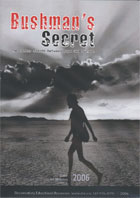
Bushman’s Secret 2006
Distributed by Documentary Educational Resources, 101 Morse Street, Watertown, MA 02472; 617-926-0491
Produced by Rehad Desai
Directed by Rehad Desai
DVD, color, 65 min.
Adult
African Studies, Holocaust and Genocide Studies
Date Entered: 05/09/2007
Reviewed by Miriam Conteh-Morgan, The Ohio State University Libraries, Columbus, OHAs many in the pharmaceutical industry and the general public became excited about the potential of a cactus plant called hoodia as a weight loss drug, few were paying close attention to the impact this could have on the people who have used the plant for centuries or the land where it grows. It is precisely this angle that Rehad Desai explores in Bushman’s Secret. With shots of a stunningly beautiful yet harsh landscape, he walks viewers through the history and culture of a people now threatened by the encroaching modern world.
Through Jan van der Westhuizen, a traditional healer from the Khomani San or Bushmen ethnic group, we learn a lot about this ancient people who have lived in the Kalahari desert for many centuries. Jan takes us on a walk through his impressive “living library” of plants, explaining the medicinal value of each. This knowledge is passed down from one generation to the next, but he fears for the next one as their way of life is being threatened by new realities which could destabilize the society. The documentary shows that the Bushmen have less land left, their language is dying, and the over-harvesting of hoodia by research companies is threatening the very existence of the plant.
This story of dispossession—of the land, its inhabitants, their cultural and agricultural wealth—is not uncommon in the discourse about colonialism. Here, even the identity of the Bushmen as the original, indigenous settlers is being questioned. However, there seems to be some hope for them. A South African research company, CSIR, and its international partners signed a deal that would bring them some benefits.
Like with many benefits, though, something would have to give. In return for greater access to formal education (in their dying language as well), many San traditions will be lost. Economic benefits offer a gain, though. According to one deal negotiated by their lawyer with the giant Anglo-Dutch company, Unilever, the Bushmen will receive three cents out of every $100 the company makes on hoodia. This amount may not sound like much, but it is a better compromise than not receiving any monetary compensation for their intellectual property. And more specifically, companies will pay greater attention to maintaining the fragile eco-system of the desert.
Desai’s documentary raises the larger issues of indigenous people’s rights and fair use of community knowledge. The digital age has spawned a new awareness of creators / authors’ rights, including areas not considered before now as being protected by intellectual property rights. If new copyright rules have been created and old ones tightened, it is to be expected that rights of groups hitherto not considered “owners” will also come under close scrutiny. This documentary highlights just one case, but it marks a new development, in that companies cannot continue to take advantage of indigenous peoples for much longer.